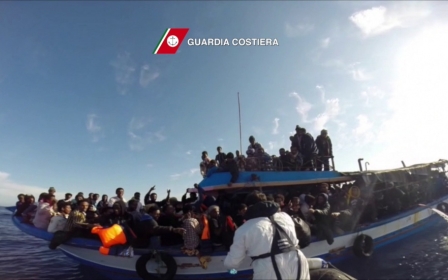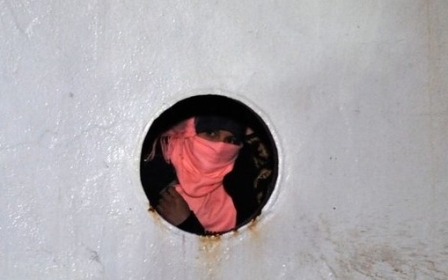Half a Titanic - the price of EU's let them drown policy

The first thing to do, if you want to cut the number of refugees from Africa and the Middle East dying while trying to cross the Mediterranean, is to drop leaflets all along the Libyan coast teaching them about ship stability. Don’t all rush to one side when you spot a ship that might save you, the pamphlets will say, because your boat will capsize and you will drown.
That’s what happened last weekend off the Libyan coast, where a boat filled with at least 700 refugees overturned when the people aboard spotted a Portuguese freighter and tried to attract its attention. (One survivor says there were 950 people aboard, including those locked below decks.) At least 650 people died – half a Titanic’s worth of casualties – although the boat in question was only 20 metres long. Only 28 people were saved.
Exactly the same thing happened with another boat crammed with refugees the previous week, and another 400 people drowned. Counting another 300-plus people who drowned in another disaster in February, the death toll right now, before the peak summer season for refugee crossings, is around 1,500. That’s a full Titanic. It’s not getting quite as many headlines, though.
So the second thing to do is to lock the European Union’s foreign ministers into a room and refuse to let them have caviar and champagne until they agree to do something about the silent massacre in the Mediterranean. Something quite effective was being done until late last year, but they deliberately stopped it.
Until late last year the Italian navy (praise be upon it) was running an operation called Mare Nostrum that went all the way to the edge of Libya’s territorial waters to pluck refugees from the sea. The operation cost 9.5 million euros a month ($10.3 million), but it rescued 100,000 people from leaking boats or the open sea. More than half of the 170,000 refugees who landed in Italy had cause to thank the Italian navy, and only one in a hundred died.
The number of refugees arriving in Italy each month is around the same this year, maybe a little higher – but 10 times as many people are dying on the way. That is because the European Union’s governments, rather than sharing the cost of the Mare Nostrum project, asked Italy to shut it down and substituted their own “Triton” operation.
Except that “Triton” is in no way an adequate substitute. It only gets a third of the funding Mare Nostrum had, and it is only supposed to operate in Italy’s coastal waters, not farther out where most of the refugee boats capsize or founder. Even this year, with the Italian navy theoretically excused from duty, it has saved twice as many people as the pathetic “Triton” operation. Which, by the way, was intended to be pathetic.
The argument the European governments made was that if you didn’t give the refugees the hope that they would be saved by the Italian navy, fewer of them would come. Right, so if you’re fleeing the civil war in Syria or the ghastly dictatorship in Eritrea, and you learn that the danger of dying on a Mediterranean crossing has gone up from one percent to 10 percent, you’re going to decide to stay in war-torn Libya instead?
Were the European governments lying to themselves, or just to everybody else? The latter, almost certainly. They were under pressure at home to stop the flow of migrants, they didn’t want to share the burden of saving them with the admirable Italians, but they couldn’t just say “Let them drown.” So they came up with that preposterous argument about deterring the migrants by making the crossing more dangerous, and shut Mare Nostrum down.
“In many countries in Europe at the moment,” said Laurens Jolles, the United Nations High Commission for Refugees (UNHCR) representative in Italy, “the (political) dialogue and the rhetoric is quite extreme and very irresponsible... It’s a fear of foreigners... but it is being exploited for populist or political reasons, especially in election periods.”
Too true. Take, for example, Katie Hopkins, columnist for The Sun, a down-market right-wing British tabloid newspaper owned by the estimable Rupert Murdoch. Last Friday, in an article headlined “Rescue boats? I’d use gunships to stop migrants”, she wrote: “NO, I don’t care. Show me pictures of coffins, show me bodies floating in water, play violins and show me skinny people looking sad. I still don’t care.”
“Make no mistake, these migrants are like cockroaches. They might look a bit 'Bob Geldof’s Ethiopia circa 1984', but they are built to survive a nuclear bomb. They are survivors ... It’s time to get Australian. Bring on the gunships, force migrants back to their shores and burn the boats.”
Saying that sort of thing is how she earns her living, but it also expresses the true sentiments of a politically significant minority not only in Britain but in most countries throughout the European Union. When the UNHCR appealed to the EU to resettle 130,000 Syrian refugees, Germany said it would take 30,000, Sweden (with a tenth of Germany’s population) took 2,700 – and the other 26 EU states only took 5,438 between them.
So the drownings will continue.
- Gwynne Dyer is an independent journalist whose articles are published in 45 countries.
The views expressed in this article belong to the author and do not necessarily reflect the editorial policy of Middle East Eye.
Photo: The body of person who died after fishing boat carrying migrants capsized off the Libyan coast, is brought ashore along with 23 others retreived by the Italian Coast Guard vessel Bruno Gregoretti at Boiler Wharf, Senglea in Malta on April 20, 2015.
New MEE newsletter: Jerusalem Dispatch
Sign up to get the latest insights and analysis on Israel-Palestine, alongside Turkey Unpacked and other MEE newsletters
Middle East Eye delivers independent and unrivalled coverage and analysis of the Middle East, North Africa and beyond. To learn more about republishing this content and the associated fees, please fill out this form. More about MEE can be found here.





